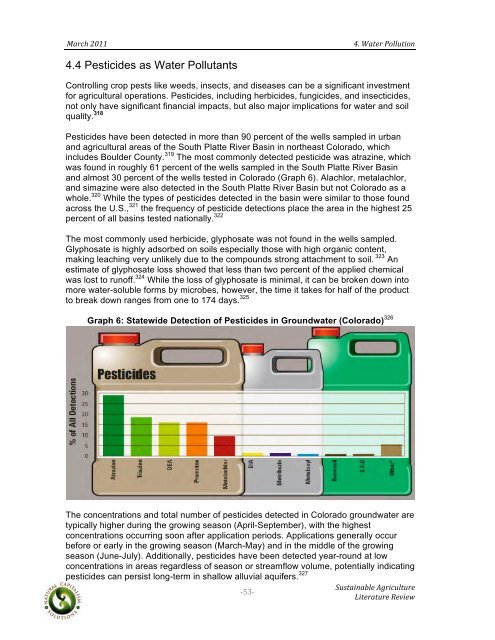Sustainable Agriculture Literature Review - Boulder County
Sustainable Agriculture Literature Review - Boulder County
Sustainable Agriculture Literature Review - Boulder County
You also want an ePaper? Increase the reach of your titles
YUMPU automatically turns print PDFs into web optimized ePapers that Google loves.
! !!<br />
"#$%&!'())!!!!!!!! !!!!!!!!!!!!!!!!!!!!!!!!!!!!!!!!!!!!!!!!!!!!!!!!!!!!!!!!!!!!!!!B=!@#-2$!CD11+-.D/!<br />
4.4 Pesticides as Water Pollutants<br />
Controlling crop pests like weeds, insects, and diseases can be a significant investment<br />
for agricultural operations. Pesticides, including herbicides, fungicides, and insecticides,<br />
not only have significant financial impacts, but also major implications for water and soil<br />
quality. 318<br />
Pesticides have been detected in more than 90 percent of the wells sampled in urban<br />
and agricultural areas of the South Platte River Basin in northeast Colorado, which<br />
includes <strong>Boulder</strong> <strong>County</strong>. 319 The most commonly detected pesticide was atrazine, which<br />
was found in roughly 61 percent of the wells sampled in the South Platte River Basin<br />
and almost 30 percent of the wells tested in Colorado (Graph 6). Alachlor, metalachlor,<br />
and simazine were also detected in the South Platte River Basin but not Colorado as a<br />
whole. 320 While the types of pesticides detected in the basin were similar to those found<br />
across the U.S., 321 the frequency of pesticide detections place the area in the highest 25<br />
percent of all basins tested nationally. 322<br />
The most commonly used herbicide, glyphosate was not found in the wells sampled.<br />
Glyphosate is highly adsorbed on soils especially those with high organic content,<br />
making leaching very unlikely due to the compounds strong attachment to soil. 323 An<br />
estimate of glyphosate loss showed that less than two percent of the applied chemical<br />
was lost to runoff. 324 While the loss of glyphosate is minimal, it can be broken down into<br />
more water-soluble forms by microbes, however, the time it takes for half of the product<br />
to break down ranges from one to 174 days. 325<br />
!<br />
Graph 6: Statewide Detection of Pesticides in Groundwater (Colorado) 326<br />
The concentrations and total number of pesticides detected in Colorado groundwater are<br />
typically higher during the growing season (April-September), with the highest<br />
concentrations occurring soon after application periods. Applications generally occur<br />
before or early in the growing season (March-May) and in the middle of the growing<br />
season (June-July). Additionally, pesticides have been detected year-round at low<br />
concentrations in areas regardless of season or streamflow volume, potentially indicating<br />
pesticides can persist long-term in shallow alluvial aquifers. 327<br />
"&$"<br />
!*+,-#./#012!34$.%+1-+$2!<br />
5.-2$#-+$2!627.28!
















